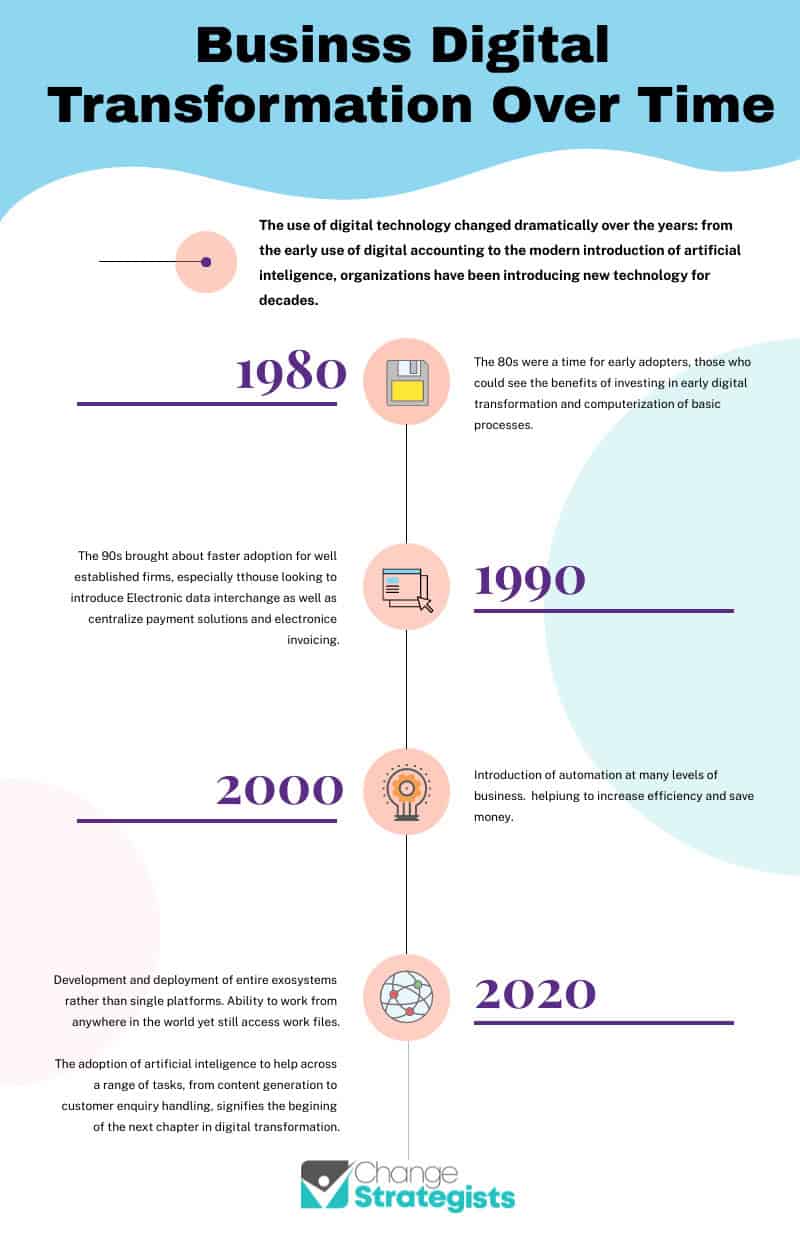The past three decades have seen rapid adoption of digital technologies in businesses. As digital systems evolved, so did businesses. This article will look at the evolution of digital transformation processes over time and what the future looks like for these processes and companies adopting them.
Digital transformation has been continuously evolving over the past three decades. What started as basic online communication and data mining has advanced into the Internet of Things and machine learning. The future of digital transformation holds the development of entire digital ecosystems as opposed to just platforms.
Digital transformations are changes in a business’s processes, policies, models, and competencies to take advantage of technological advancements.
These changes enable businesses to stay updated with new technology and help improve their efficiency.
Let’s look at how these processes have evolved and what they look like now.
The Evolution of Digital Transformation
Almost 30 years ago, digital transformation was simply used for digitizing and computerizing existing processes.
For example, invoicing systems being transformed into using digital invoices instead of paper for record-keeping.
A decade ago, digital transformation was considered the same as IT. It was considered to be limited to just technical tasks and maintenance work.
Organizations were mainly focused on using digital technologies to communicate virtually, mine data, and utilize search technology.
Today, digital transformation is a more holistic concept that encompasses the entire business operation. A digital strategy now aims to improve all business aspects to drive productivity and efficiency. This includes all domains ranging from marketing to HR.
Digital transformation in today’s age is advancing toward machine learning, artificial intelligence, and the Internet of Things.
Organizations are looking at newer, more efficient ways to automate processes and streamline operations.
Let’s take a brief look at what digital transformation has entailed over the past few decades.

As far as the evolution of the domain goes, digital transformation has seen the most rapid growth in the past decade, specifically the last five years.
Key Takeaways From Last Decade of Digital Transformation
Different businesses and sectors have made the change to digital. These companies have improved their processes and operations and increased the value they provide their customers through a much better experience.
This last decade has seen the rise of social media, artificial intelligence, cloud computing, etc. These domains have significantly impacted different sectors, including business structures, finances, operations, resource handling, and communication.
Let’s explore the major takeaways from the last decade and see how digital transformation is moving towards developing entire business ecosystems.
Desktop Automation isn’t Digital Transformation.
In the early 2000s, companies began embracing digital channels to conduct their day-to-day operations. This meant replacing the old paper-dependent methods of creating, storing, and sharing data via computers.
Over time, companies realized that their workforce needs an upgrade too, and it is becoming far more challenging to deal with these ever-expanding legacy systems. The introduction of disciplines like AI, machine learning, cloud computing, and social media have made digital transformation an all-encompassing process.
It is no longer limited to automating or digitizing day-to-day tasks. Digital transformations span different workflows and teams and integrate systems within an organization.
As a result, organizations that understand digital transformation is a continuously evolving process benefit more than those who limit themselves to simple desktop automation.
AI has Revolutionized Data Mining and Process Discovery.
A decade ago, organizations struggled to automate their workflows and tasks to increase efficiency. They were still processing information manually, and process flows were long, drawn-out, and suffering from human-related blockers.
AI is a technology that simulates human-like behavior using human intelligence-based case scenarios. AI and machine learning have made automated analysis and predictive analytics a reality. This has sped up process workflows and mapping for business owners and technical teams.
This agility has enabled many organizations to use AI and machine learning to automate their operations, enhance productivity, and provide better customer value.
Digital Transformation Depends on Business Owners
Unlike the early 90s and 2000s, where technological initiatives were left in the hands of technical experts, business owners play a more vital role in transformations today.
Access to low or no-code technology makes it easy for business owners to make changes independently without having to invest heavily in technical resources.
As technology evolves and becomes more user-friendly and limits dependencies on IT departments, more and more business owners are empowered to automate their processes and modes of operation.
Data Analytics is the Real Value Driver in Digital Transformations
Technology gave business owners new channels and avenues to collect data. However, business owners soon realized that all this data is useless until it is appropriately structured and converted into actionable insights.
Big data analytics, AI, and machine learning have enabled organizations to categorize, extract and organize their data to help them make more informed decisions.
This data and insights can then be used to automate critical business workflows and processes.
Now more than ever, businesses need to realize the importance of being agile and adaptive to new changes.
Technological advancements are happening at lightning-fast speeds, and end-users must be equipped with the right mindset, tools, and processes to adapt to these changes.
So, what are the key pillars of digital transformations?
Key Pillars of Digital Transformation
Each organization’s digital transformation journey is different based on its “digital maturity” level. This has to do with the extent of digitization it’s already gone through.
There are generally four key pillars of digital transformation. Most companies adopt the earlier ones as they start their journey of transformation and come to later ones down the road as they achieve more digital maturity.
IT Upgrade
For most companies, a digital transformation’s first step is upgrading their IT infrastructure and systems to match the latest technologies and best practices. Companies use this opportunity to assign a budget to digitize their communication and IT platforms.
A successful IT upgrade will result in low-cost infrastructures, increased employee productivity and satisfaction, and reduced maintenance costs. Many companies have done this successfully, while others are still determining what this looks like for their organization.
It requires a significant budget to make these changes and venture into machine learning and AI domains. However, in the end, it will provide immense value to the way you do business by reducing IT costs and providing security solutions to your customers.
Digital Transformation of Operations
The second pillar of digital transformations is using digital channels and means to analyze, optimize, rationalize and implement modes of operations. This could mean replacing analogue work with digital processes in the most basic form.
This is one change you will not be able to ignore for long because this will ensure your survival in the market. Without adapting to these changes in your processes, you will be made obsolete compared to competitors who’ve already digitized their processes.
Processes and modes of operations may take some time to transform and reach their ultimate best state. A company may start with altering methods and then, during the course of doing so, discover that they have to completely re-do them. Such is the nature of these transformations; they are ever-evolving.
Digital Marketing
If there is one domain of doing business that has transformed the most, it’s marketing. Digital marketing has opened doors for businesses to acquire new customers, retain old ones, sell online, increase brand awareness, and much more through digital channels.

It has reduced the costs of marketing a business significantly. In addition, it also requires companies to invest in different kinds of resources such as automation platforms, design assets, digital tools, and clean data sources.
Many major global retailers use AI and predictive analytics to analyze their prospective and returning clients. They model customer behavior and create marketing campaigns accordingly.
Digital marketing tools can help you identify new opportunities and open a channel for feedback for your customers.
A business can invest in this pillar when other systems and processes have been transformed to complement it.
New Products and Opportunities
Digital transformations allow businesses to explore more opportunities for growth and newer ways of doing business. It will enable companies to create new products, sub-services, and business models.
It can even open up the road to interacting with a larger ecosystem to explore new ventures and areas of business growth.
Using digital avenues to create new ventures requires your business to be at a relatively higher level of digital maturity. This will go beyond the regular IT uplifts or digitization of processes.
It means investing in resources that understand data analytics and the creation of new business models based on existing data. A workforce that genuinely understands what it is to build ecosystems and integrate ideas will ensure this stage is achieved with success.
What Makes a Digital Transformation Successful?
Just like any other process, the digital transformation process also has specific steps you can take to ensure your journey is a successful one. You will need to invest in the right tools and develop the required processes before you can do any of the following:
Align Culture and Perceptions
It doesn’t matter how much time and money is invested into a new process or tool unless everyone in the company knows how to use it and is on board with it. Before implementing a change or introducing a new device, make sure your employees know about it and how to use it to their advantage.
Give your employees regular incentives to learn and improve. This will make adapting to change a norm easy for them.
Future-Proofing through Analysis
When making a change in your processes, the biggest question you should ask yourself is: “Why do we need to do this?”
You must do a constant analysis of what is working for the business and what isn’t. Constantly evaluating your current processes will help you determine where and why transformation is required.
When investing in or developing software, remember that new challenges may be just around the corner. You need to do a little bit of predictive thinking and go for a solution that can serve for a reasonable amount of time.
Connecting New and Existing Workforces
Every company has a set way of doing certain things. Whether these ways are efficient, employees and stakeholders are used to them. Technology changes at a very fast pace, and you can’t keep changing how you do things every time a new technology is on the horizon.
You will still need to change your systems now and then, adding new layers to old ones and discarding some in the process. The best course of action is to look for a solution that has constant upgrades and provides training with these upgrades.
Building a Coherent Systems
Getting new software for every facet of the business can be tempting, but you don’t want to end up managing twenty different tools. Not only will your cost of doing business skyrocket, but it will also be a management disaster for you in the long run.
Invest in solutions that come with integrations for several platforms. Comprehensive management software solutions are the future for small and large businesses, and it will be wise for you to invest in them from the get-go.
Have a Clear Evaluation Process
Having great software in place is excellent. However, you can’t be hands-off with the process. You need to set an annual or bi-annual evaluation of your digital transformation goals. This is the time when you will assess the effectiveness of your endeavours and determine whether you need to make any changes.
Frequently Asked Questions
What is the key trend in digital transformation in 2022?
Multi-cloud solutions are a key trend in digital transformation in 2022. Companies are moving towards using multiple service providers for housing and sharing their data.
What is a digital transformation strategy?
A digital transformation strategy is a series of steps designed to use digital tools to improve aspects of your business, including operations, sales, marketing, processes, etc.
Final Thoughts
Digital transformation has seen tremendous evolution in the past three decades. It has come a long way from computerizing basic processes to machine learning. Digital transformation continues to evolve and is more focused on building integrated ecosystems than just primary platforms.





